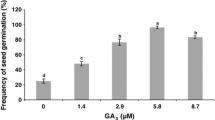Abstract
Aloe vera L., a member of Liliaceae, is a medicinal plant and has a number of curative properties. We describe here the development of tissue culture method for high-frequency plantlet regeneration from inflorescence axis-derived callus cultures of sweet aloe genotype. Competent callus cultures were established on 0.8% agar-gelled Murashige and Skoog’s (MS) basal medium supplemented with 6.0 mg l−1 of 2,4-dichlorophenoxyacetic acid (2,4-D) and 100.0 mg l−1 of activated charcoal and additives (100 mg l−1 of ascorbic acid, 50.0 mg l−1 each of citric acid and polyvinylpyrrolidone, and 25.0 mg l−1 each of l-arginine and adenine sulfate). The callus cultures were cultured on MS medium containing 1.5 mg l−1 of 2,4-D, 0.25 mg l−1 of Kinetin (Kin), and additives with 4% carbohydrate source for multiplication and long-term maintenance of regenerative callus cultures. Callus cultures organized, differentiated, and produced globular embryogenic structures on MS medium with 1.0 mg l−1 of 2,4-D, 0.25 mg l−1 of Kin, and additives (50.0 mg l−1 of ascorbic acid and 25.0 mg l−1 each of citric acid, l-arginine, and adenine sulfate). These globular structures subsequently produced shoot buds and then complete plantlets on MS medium containing 1.0 mg l−1 of 6-benzylaminopurine and additives. A hundred percent regenerated plantlets were hardened in the greenhouse and stored under an agro-net house/nursery. The regeneration system defined could be a useful tool not only for mass-scale propagation of selected genotype of A. vera, but also for genetic improvement of plant species through genetic transformation.


Similar content being viewed by others
References
Dange, E., Bisrat, D., Vilnoen, A., & Van Wyk, B. E. (2000). Current Organic Chemistry, 4, 1055–1078. doi:10.2174/1385272003375932.
Reynolds, T., & Dweck, A. C. (1999). Journal of Ethnopharmacology, 68(1–3), 3–37.
Rosca-Casian, O., Parvu, M., Vlase, L., & Tamas, M. (2007). Fitoterapia, 78(3), 219–222. doi:10.1016/j.fitote.2006.11.008.
Natali, L., Sanchez, I. C., & Cavallini, A. (1990). Plant Cell, Tissue and Organ Culture, 20(1), 71–74. doi:10.1007/BF00034761.
Roy, S. C., & Sarkar, A. (1991). Scientia Horticulturae, 47, 107–113.
Meyer, H. J., & van Staden, J. (1991). Plant Cell, Tissue and Organ Culture, 26(3), 167–171. doi:10.1007/BF00039939.
Abrie, A. L., & van Staden, J. (2001). Plant Growth Regulation, 33, 19–23. doi:10.1023/A:1010725901900.
Liao, Z., Chen, M., Tan, F., Sun, X., & Tang, K. (2004). Plant Cell, Tissue and Organ Culture, 76(1), 83–86. doi:10.1023/A:1025868515705.
Aggarwal, D., & Barna, K. S. (2004). Journal of Plant Biochemistry and Biotechnology, 13, 77–79.
Velcheva, M., Faltin, Z., Vardi, A., Eshdat, Y., & Perl, A. (2005). Plant Cell, Tissue and Organ Culture, 83(3), 293–301. doi:10.1007/s11240-005-7192-1.
Bairu, M. W., Stirk, W. A., Dolezal, K., & van Staden, J. (2007). Plant Cell, Tissue and Organ Culture, 90, 15–23. doi:10.1007/s11240-007-9233-4.
Singh, M., Rathore, M. S., Panwar, D., Rathore, J. S., Dagla, H. R., & Shekhawat, N. S. (2009). Journal of Sustainable Forestry, 28, 935–950. doi:10.1080/10549810903344660.
Murashige, T., & Skoog, F. (1962). Physiologia Plantarum, 15, 473–479. doi:10.1111/j.1399-3054.1962.tb08052.x.
Dubey, T., & Guerra, D. J. (2002). Recent Progress in Medicinal Plants, 5, 47–61.
Turker, G. (1999). Current Opinion in Biotechnology, 14(2), 221–225. doi:10.1016/S0958-1669(03)00031-4.
Vines, G. (2004). Herbal harvests with a future: towards sustainable source for medicinal plants. Salisbury: Plantlife International.
Canter, P. H., Thomas, H., & Edzard, E. (2005). Trends in Biotechnology, 23(4), 180–185. doi:10.1016/j.tibtech.2005.02.002.
Correll, M. J., & Weathers, P. J. (2001). In Vitro Cellular & Developmental Biology- Plant, 37, 405–413. doi:35400009656415.0160.
Correll, M. J., Wu, Y., & Weathers, P. J. (2001). Biotechnology and Bioengineering, 71(4), 307–314. doi:10.1002/1097-0290.
Acknowledgements
We are grateful to the Department of Biotechnology (DBT), Ministry of Science and Technology, Government of India for providing funds for the establishment of micropropagation and hardening facilities at Department of Botany, Jai Narain Vyas University, Jodhpur. The University Grant Commission (UGC) and the Department of Science and Technology (DST), Government of India also supported our research under Special Assistance Phase III (SAP) and Funds for Infrastructure and Development in Science and Technology (FIST) program, respectively.
Author information
Authors and Affiliations
Corresponding author
Rights and permissions
About this article
Cite this article
Rathore, M.S., Chikara, J. & Shekhawat, N.S. Plantlet Regeneration from Callus Cultures of Selected Genotype of Aloe vera L.—An Ancient Plant for Modern Herbal Industries. Appl Biochem Biotechnol 163, 860–868 (2011). https://doi.org/10.1007/s12010-010-9090-1
Received:
Accepted:
Published:
Issue Date:
DOI: https://doi.org/10.1007/s12010-010-9090-1




